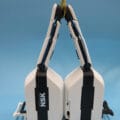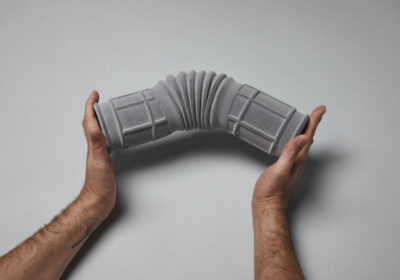Introduction to Series
In this 3-part series of articles, we will embark on a comprehensive exploration of 3D printing / additive manufacturing (AM), where our main focus is empowering you to make informed decisions about how to engage with the technology across an ever-evolving landscape. Designed to guide both beginners and those with a basic understanding through the decision-making process, we unravel the complexities surrounding 3D printing technologies, materials, and relevant business considerations. Providing key insights into the latest advancements, these articles aim to support your strategic decision-making for engaging with 3D printing, whether that is for in-house 3D printing or outsourcing to service providers.
Guiding us along this journey are two seasoned experts from the AM world. Nick Allen, CEO at 3DPRINTUK and Neil Sewell, CEO (Solid Print3D). 3DPRINTUK is a 3D printing service bureau, started in 2011, specialising in SLS and MJF powder bed fusion technology and Solid Print3D is a leading, impartial distributor of a range of 3D printing systems and additive adjacent technologies. Solid Print3D offers a wide range of technology brands including Formlabs, Bambu Labs and Big Rep.
Part 1: The Evolving World of AM
3D printing / Additive manufacturing (AM) is a rapidly growing and constantly evolving technology field that presents a dizzying array of opportunities for engineering and manufacturing organisations. The opportunities are real, but so too is the disorientation for smaller or medium sized enterprises (SMEs) when confronted by the number and nature of different 3D printing technologies and how to best utilise one, more or none of them.
3D printing can support a wide range of applications across the manufacturing workflow for prototyping, tooling and, increasingly, the production of end use parts. Today, the most prolific use of 3D printing remains as a prototyping tool for product development workflows. 3D printing can be used relatively easily to create prototypes of new products quickly and cheaply. Faster prototyping cycles with shorter (or no) lead times allows for more product iterations without incurring excessive costs. This ‘fail fast and often’ approach invariably produces a higher quality end product that has been fully optimised before the point of no return with the heavy investment required for tooling or full production.
3D printing can also support the development and production of custom tooling for production runs as well as for jigs and fixtures. For SMEs this offers the opportunity to improve their production processes and significantly reduce costs.
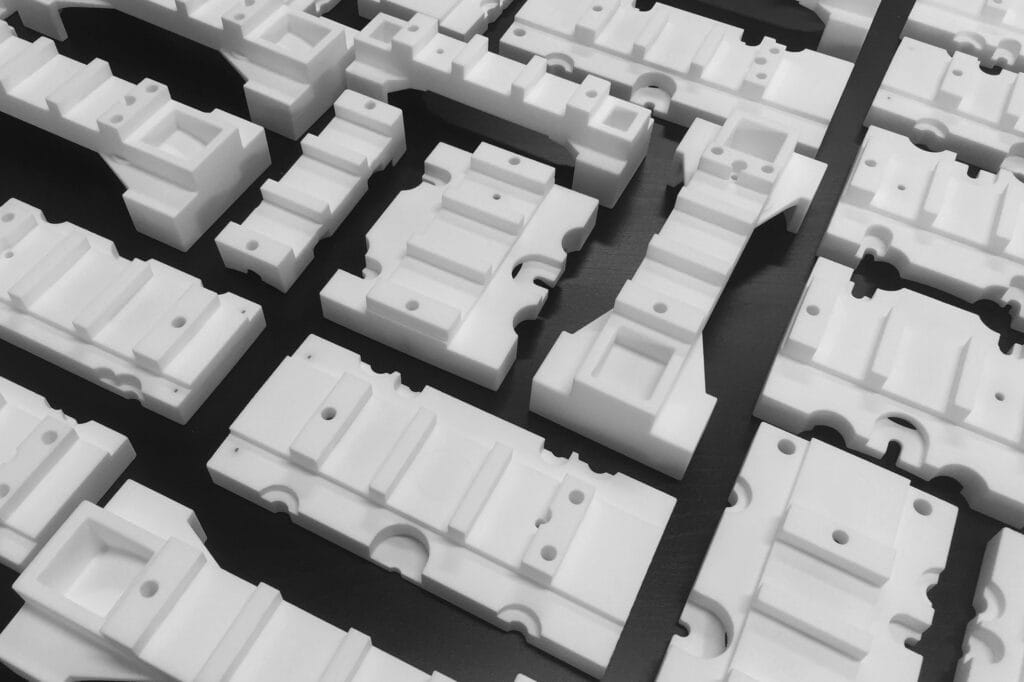
Custom designed 3D printed jigs for brush making machines, resulting in a significant reduction in costs compared to the aluminium machined alternative.
Increasingly, 3D printing is being adopted directly as a method of production for end-use parts. When designed specifically for the process, this can bring a raft of key financial and innovative opportunities for new products (that are both stronger and lighter in weight) or improve existing products.
Most industry sectors now benefit from the adoption of 3D printing in one form or another across their product development workflows. The availability and accessibility of desktop 3D printers and/or laboratory-friendly systems have made 3D printing a more prevalent prototyping tool. For production, however, it’s generally a top-down model where OEMs with the resources (financial and workforce skills) have integrated AM processes to develop, qualify and certify key applications for production. Supply chains then catch on, and have also invested in AM as a manufacturing tool in a number of ways. Leading industrial sectors include aerospace, automotive, power & energy, medical, dental and consumer goods.
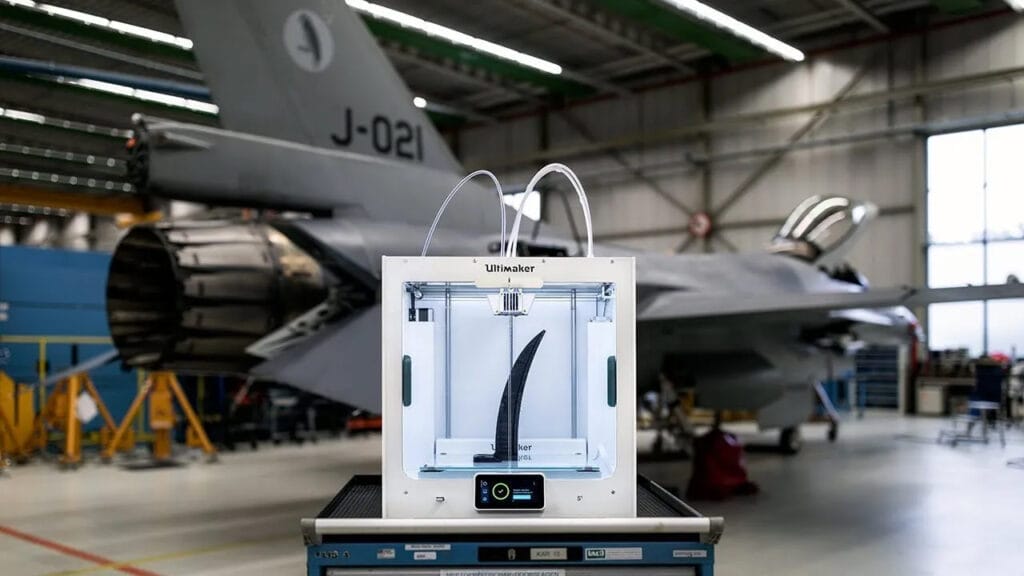
Royal Netherlands Air Force print custom-made tools, fixtures, and prototypes inhouse with UltiMaker 3D printers.
The AM industrial landscape is complex and constantly evolving, with new technologies, materials, and applications emerging all the time. There are a wide range of AM technologies available, the core technology groups are defined here, and each has its own strengths and weaknesses. Often cited as one of the limiting factors of 3D printing, the range of materials that can be used for AM is now much more extensive and constantly expanding. This includes metals, polymers, composites, and biomaterials.
So where does this leave a typical SME considering 3D printing for the first time?
There are really two key options for SMEs that want to engage with 3D printing:
- Purchase a 3D printer and bring it in-house.
- Use a 3D printing service bureau.
Which Way?
One, other, both, neither?
The answer to this has to be rooted, deeply, in the application at hand.
The nature of any application — the part— is what will have brought you to this point and unfortunately, there is no one answer that fits all, just more questions! But if you can work through them and answer them honestly, you will more likely than not identify the right direction for YOUR business and be able to maximise the advantages of 3D printing for YOUR application.
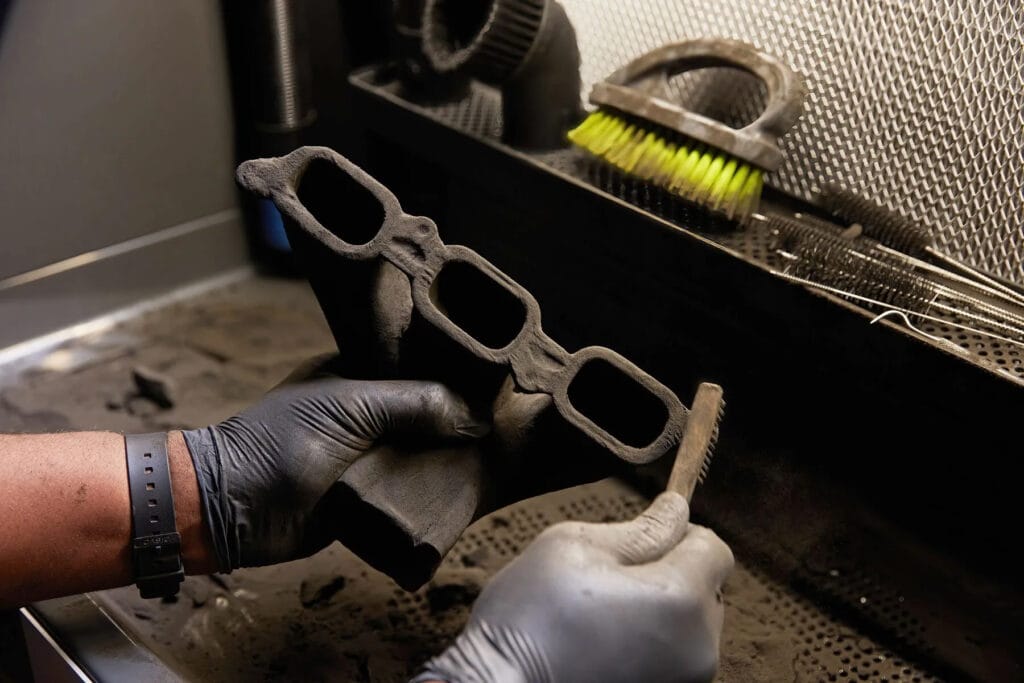
Whether in-house or outsourced, for production or prototype applications, all 3D printed parts require post-processing steps once they have been removed from the machine.
Considerations:
Can 3D printing add value to my workflow / new product?
At the prototyping stage of a new product development workflow, the answer will almost always be yes. 3D printing allows engineers to create prototypes of new products quickly and easily. This means that they can test and refine their designs early in the development process, which will invariably save time and money.
Another area 3D printing can add value is offering designers and engineers more freedom to design complex products and parts. This is because 3D printing processes are not as constrained as more traditional manufacturing methods. However, it is important to say that there are still some constraints, they’re just different. This is only a valid consideration if designing a product that will be produced using additive technologies, for prototyping and tooling, it is not really applicable. However, for end use parts there are significant opportunities for component consolidation and therefore reduced assembly, stronger and lighter parts and true innovation that can drive industry sectors forward.
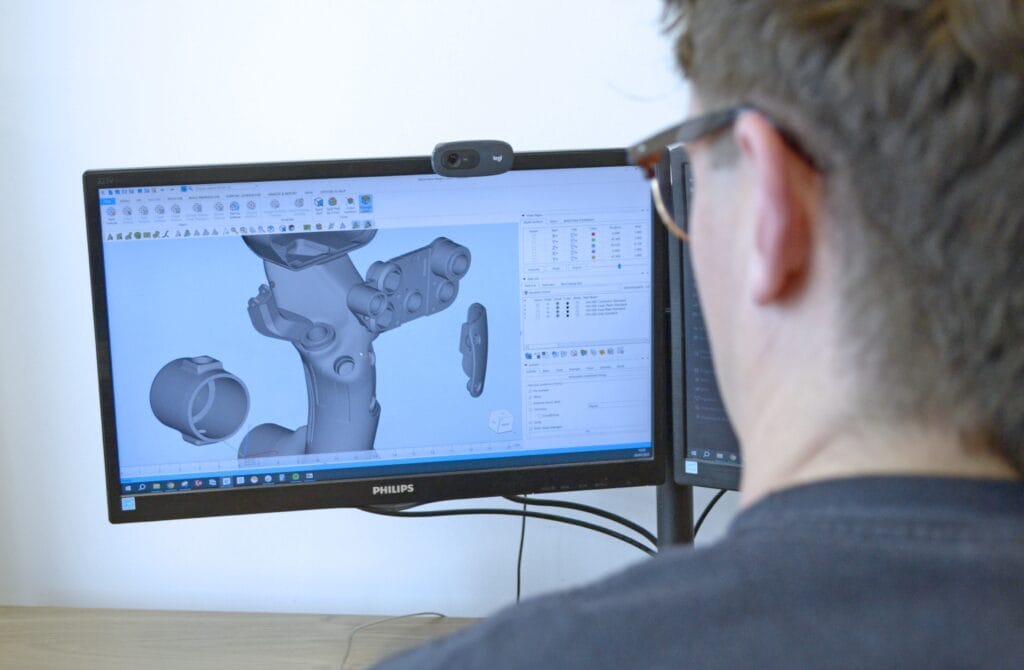
Do we require 3D printing for prototyping / tooling / production / a combination thereof?
The benefits of each of these are outlined briefly above, and don’t need repeating here. Ultimately, knowing your business and your applications; only you can answer that question.
But if the answer is yes to any of the options … then comes the big one:
3D Printing in-house versus outsource to a service bureau?
In general terms you will need to consider the ROI on initial capital investment + running/consumable costs of owning a 3D printer versus the fees charged by a subcontract bureau over the lifetime of the product(s). The application requirements will then likely narrow down the technology requirements in terms of capabilities and materials that can be processed together with part volumes. But to provide some examples across the spectrum:
1-off concept models of new products to test form and fit through numerous iterations
5-off functional prototypes for testing
10-50 pre-production models for market testing
1-off high end, fully customised final parts
20-30 end use parts per month
100 end use parts per month
1000 end use parts per month
10,000 production parts
100,000 production parts.
Your number is probably different, but suffice to show that the volume of parts required and the frequency of 3D printing jobs is a vital factor in determining your choice, and, ultimately the most important number of all — the cost per part. (Later in this series, we will explore these issues with some specific case studies.)
Because of its history as a prototyping solution and its gradual evolution into a manufacturing solution, 3D printing is associated with very low volumes. Realistically, today, industrial 3D printing processes can be considered as a viable option for volumes up to 10,000 parts. Anything over 20,000 parts and IM has to be considered as the most viable option. 3D printing does not compete with IM at very high volumes, that’s just a fact. There is also that grey area between 10k and 20k where either industrial 3D printing or injection moulding could work best for your application, depending on part size, part variations and updates and batch requirements. However, that is a subject for another time.
Another significant factor to consider is the space and infrastructure that is required to house and operate a 3D printer. Again, the spectrum is broad here, from a desktop FDM machine running filament materials which would be at the easy end of the spectrum (relatively speaking) and take up minimal space, through desktop resin 3D printer options, to high end industrial powder bed fusion 3D printers with all of the powder handling, filtration and post-processing ancillaries that this entails that would be at the most complex and demanding end of the spectrum.
Another general consideration that cannot be overlooked is the skills that are available to manage and integrate 3D printing into your workflow. Consider if you have or can develop the necessary expertise to operate and maintain a 3D printer effectively, and whether the associated costs in terms of time and money are equal to or add to the value of the workflow. Most 3D printer brands, and / or their resellers offer comprehensive training programmes to support upskilling of existing personnel, but they do require additional investment and time commitments as well as buy-in from staff.
For outsourced 3D printing projects there are various considerations including but not limited to lead times, protecting IP, lack of control over delivery times and 3rd party deliveries.
Help is available:
The Trimech Group covers the spectrum and can support you to get the solution you need, when you need it to get the added value you require from 3D printing technologies whether it is to support your product development workflow (prototyping) or your production workflow.
As a customer-centric group of companies the Trimech Group can support one option, or the other as well as support you transitioning either way. They can leverage their extensive knowledge of 3D printing to best meet YOUR needs.So, to round up: what would make most sense for you and when?
The most significant factor here is YOUR context in terms of the size of your business, the type of parts you are considering 3D printing, the volumes of said parts and identifying the best technology to achieve it.
These are all considerations that we will delve into in more detail in Part 2 of this series of articles.
In the meantime if you would like to receive a free 3D printing sample pack, visit the 3DPRINTUK website. (This offer is valid for residents of the UK, including Northern Ireland, only.)
Solid Print3D provides businesses with unbiased guidance and top-notch 3D printing, scanning, and manufacturing solutions. Check out our portfolio, request a free sample, and schedule a showroom demo with our experts. (This offer is valid for residents of the UK, including Northern Ireland, only.)


